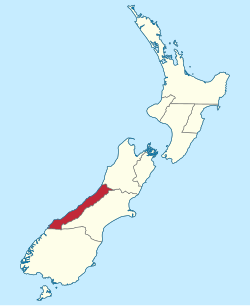Area and history
The area was part of Canterbury Province when the provinces were created in 1853. By 1868, triggered by the population growth associated with the West Coast gold rush, the West Coast region was separated from Canterbury Province with the formation of the County of Westland. The boundary to Canterbury was defined as the crest of the Southern Alps / Kā Tiritiri o te Moana.
This county was not a true province, as it had all the administrative powers of a provincial council, but saw the legislative powers remain with Parliament in Wellington. Members of Parliament were not happy with having to spend their time on local legislation, and in 1873 the government elevated the county to full provincial status – the last of the 10 New Zealand provinces to be established. [1]
The province covered an area roughly the same as the present day Westland District, on the West Coast of New Zealand. The boundary with the Nelson Province was, as per George Grey's proclamation from February 1853, the Grey and Arnold Rivers, Lake Brunner, and from there to the headwaters of the Hurunui River through then virtually unknown territory. [1]
When John Hall resigned as Westland county chairman the government appointed James Bonar. Bonar was chairman during the period of the Fenian riots and is credited with "great tact in handling that explosive situation".
In March 1868, Bonar swore in 640 special constables to suppress an Irish nationalist procession in Hokitika. Bonar was replaced by Conrad Hoos, but later—when on 1 December 1873 Westland split from Canterbury Province—Bonar resumed, but as the provincial superintendent.
This page is based on this
Wikipedia article Text is available under the
CC BY-SA 4.0 license; additional terms may apply.
Images, videos and audio are available under their respective licenses.
